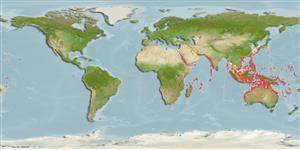Environment: milieu / climate zone / depth range / distribution range
Ökologie
seewasser riff-verbunden; tiefenbereich 0 - 55 m (Ref. 26165), usually 5 - 35 m (Ref. 27115). Tropical; 22°C - 28°C (Ref. 27115); 35°N - 36°S, 24°E - 169°W
Indo-West Pacific: Red Sea and Natal, South Africa to Niue (Ref. 37816), north to Japan, south to Australia. Recorded from Europa Island (MNHN 1992-0508).
Size / Gewicht / Alter
Maturity: Lm ? range ? - ? cm
Max length : 15.0 cm TL Männchen/unbestimmt; (Ref. 9710); 7.0 cm TL (female)
Rückenflossenstacheln (insgesamt): 10; Rückenflossenweichstrahlen (insgesamt): 15-17; Afterflossenstacheln 3; Afterflossenweichstrahlen: 6 - 7. Color patterns vary from one locality to another.
Adults are found above coral outcrops or patch reefs of clear lagoons, channels, or outer reef slopes. Form large aggregations. Feed on zooplankton (Ref. 6113). A protogynous hermaphrodite (Ref. 55367). Males are territorial and haremic (Ref. 9710). Color patterns and size of sexual transition very slightly from one locality to the next. Total length for females from Ref. 9137.
Life cycle and mating behavior
Geschlechtsreife | Fortpflanzung | Ablaichen | Eier | Fecundity | Larven
Pelagic spawner. A monandric species (Ref. 55367). Females are induced to change sex by removal of males from social groups (Ref. 38802). Sex-reversal is completed in 2-4 weeks after male removal in the area, or 170-280 days in an all female group (Ref. 34185, 34249, 34250). Length at sex change = 5.0 cm TL (Ref. 55367). Also Ref. 103751.
Successful males spawn nightly with successive females (Ref. 37816).
Randall, J.E., G.R. Allen and R.C. Steene, 1990. Fishes of the Great Barrier Reef and Coral Sea. University of Hawaii Press, Honolulu, Hawaii. 506 p. (Ref. 2334)
IUCN Rote Liste Status (Ref. 130435)
Bedrohung für Menschen
Harmless
Nutzung durch Menschen
Fischereien: weniger kommerziell; Aquarium: Kommerziell
Mehr Information
ReferenzenAquakulturAquakultur ProfilZuchtlinienGenetikElectrophoresesVererbbarkeitKrankheitenVerarbeitungNutrientsMass conversion
Tools
Zusatzinformationen
Download XML
Internet Quellen
Estimates based on models
Preferred temperature (Ref.
123201): 24.3 - 28.9, mean 27.6 °C (based on 1000 cells).
Phylogenetic diversity index (Ref.
82804): PD
50 = 0.5000 [Uniqueness, from 0.5 = low to 2.0 = high].
Trophic level (Ref.
69278): 3.4 ±0.45 se; based on food items.
Generation time: 1.8 ( na - na) years. Estimated as median ln(3)/K based on 1
growth studies.
Widerstandsfähigkeit (Ref.
120179): hoch, Verdopplung der Population dauert weniger als 15 Monate. (K=0.6).
Fishing Vulnerability (Ref.
59153): Low vulnerability (23 of 100).
Nutrients (Ref.
124155): Calcium = 83.1 [47.1, 158.8] mg/100g; Iron = 0.796 [0.436, 1.349] mg/100g; Protein = 18 [16, 20] %; Omega3 = 0.167 [0.104, 0.269] g/100g; Selenium = 26.4 [15.1, 50.7] μg/100g; VitaminA = 207 [72, 672] μg/100g; Zinc = 1.48 [0.99, 2.13] mg/100g (wet weight);
